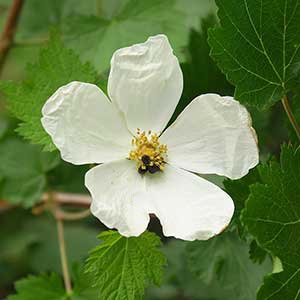Rubus bartonianus
Rubus deliciosus
Barton's raspberry, bartonberry
boulder raspberry, delicious raspberry
erect, sparsely short-hairy, glabrescent, eglandular, not pruinose.
decumbent to erect, glabrous or sparsely short-hairy, eglandular or sparsely stipitate-glandular, not pruinose.
deciduous, simple;
stipules lanceolate, 4–6 mm;
blade cordate to broadly ovate, (2–)2.5–4(–5) × (2.5–)3.5–4.5(–5.5) cm, base deeply cordate, 3–5-lobed, lobe apices acute to obtuse, margins coarsely doubly dentate, abaxial surfaces glabrous or sparsely hairy, eglandular or sparsely stipitate-glandular.
deciduous, simple;
stipules lanceolate to narrowly ovate, 5–8(–14) mm;
blade orbiculate to reniform, (1.5–)2–4(–5) × (2.5–)3–4.5(–7) cm, base shallowly cordate, 3–5(–7)-lobed, lobe apices broadly rounded to obtuse, margins doubly dentate, abaxial surfaces sparsely hairy, mostly along veins, sparsely stipitate-glandular.
1-flowered.
1-flowered.
moderately hairy, eglandular or sparsely stipitate-glandular.
pubescent, sparsely to densely short- to long-stipitate-glandular.
bisexual;
petals white, obovate, (15–)20–25 mm;
filaments filiform;
ovaries glabrous, styles clavate, villous.
bisexual;
petals white, obovate to ovate, 15–25(–30) mm;
filaments filiform;
ovaries glabrous, styles clavate, villous.
deep red, hemispheric, to 1 cm;
drupelets 10–30, coherent, separating from torus.
dark purple, hemispheric, to 1 cm;
drupelets 10–40, coherent, separating from torus.
= 14, 21.
Rubus bartonianus
Rubus deliciosus
Of conservation concern.
Rubus bartonianus is distinguished from the other flowering raspberries within its geographic range by its erect, unarmed stems, relatively small, simple leaves with acute to obtuse lobes, deeply cordate bases, sparsely hairy or glabrous abaxial surfaces, relatively large flowers with white petals, and densely long-hairy, clavate styles. The leaves superficially resemble those of Acer glabrum or some species of Ribes.
Rubus bartonianus is most similar to R. neomexicanus but especially R. deliciosus. The species is known only from the Snake River Canyon of Idaho and Oregon.
(Discussion copyrighted by Flora of North America; reprinted with permission.)
Rubus deliciosus is recognized by its decumbent to erect, unarmed stems, relatively small simple leaves with obtuse to broadly rounded lobes, shallowly cordate bases, sparsely hairy abaxial surfaces, large flowers, white petals, glabrous or sparsely hairy sepals, and densely villous clavate styles. The distinction between R. deliciosus and R. neomexicanus is not always clear, especially when the former has more narrowly obtuse lobes and denser leaf abaxial hairs. Rubus deliciosus is also similar to R. bartonianus of Idaho and Oregon, as well as the Mexican R. trilobus Seringe. It might be reasonable to recognize a broader concept of R. deliciosus, one containing multiple infraspecific. Rubus deliciosus and its close relatives require a revisionary study.
Rubus deliciosus has long been planted for its ornamental value because of its large, showy flowers.
(Discussion copyrighted by Flora of North America; reprinted with permission.)


